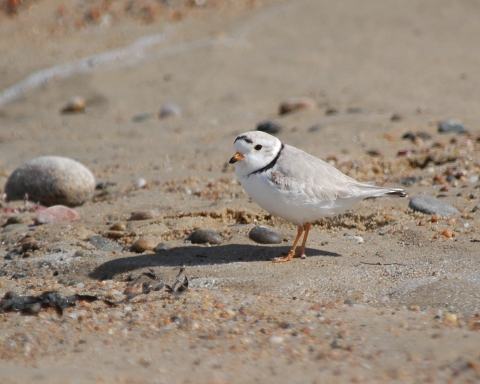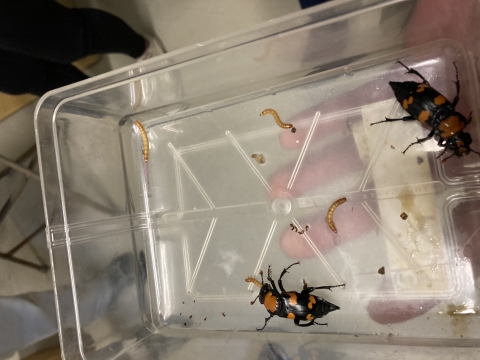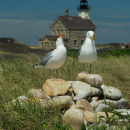What We Do
Wildlife Conservation is at the heart of the National Wildlife Refuge System. It drives everything on the U.S. Fish and Wildlife Service lands and waters managed within the Refuge System from the purposed for which a national wildlife refuge national wildlife refuge
A national wildlife refuge is typically a contiguous area of land and water managed by the U.S. Fish and Wildlife Service for the conservation and, where appropriate, restoration of fish, wildlife and plant resources and their habitats for the benefit of present and future generations of Americans.
Learn more about national wildlife refuge is established to the recreational activities offered to the resource management tools used. Using conservation best practices, the Refuge System manages Service lands and waters to help ensure the survival of native wildlife species.
Piping Plover
After a male piping plover clears a small nesting area near the first seaside row of dunes, a female lays camouflaged eggs, usually four. If a fox or another predator approaches, she moves off the nest and displays a broken wing act worthy of an Academy Award, designed to lure the intruder away from her eggs. Hours after they hatch, plover chicks leave the nest to feed. Their trips to the ocean’s edge can be dangerous when they have to dodge people and dogs. The chicks are so well camouflaged that, before nesting areas were closed to the public, these “walking cotton balls” were often killed by beach-going vehicles.
American Burying Beetle
Block Island harbors one of only a handful of American burying beetle populations, and the only natural population known east of the Mississippi River. This beetle is the largest of the North American carrion beetles, whose numbers have so drastically declined that they were federally-listed as endangered in 1989. They have been documented on or adjacent to refuge land, including near Beane Point and just north of Great Salt Pond. Beetles on the refuge are likely foraging primarily on dead pheasant chicks, and occasionally on dead gull and black-crowned night-heron chicks. Carrion availability may be the single greatest factor determining where the species can survive.
Lou Perrotti, Director of the Conservation Breeding Program of the Roger William Park Zoo breeds American Burying Beetles, to be released at suitable habitats, such at native grasslands at Block Island and Nantucket.
Fiddler Crab
Fiddler crabs are a common sight along the coastline of the Beane Point Unit of the Block Island Refuge. With the males easily recognizable due to having one claw larger than the other, this crustacean is a detritivore, sifting through sediment for algae, microbes and fungus to eat.
Cobble Beach
These expanses are vital feeding and nesting areas for migrating birds - and are critical breeding habitat for the threatened piping plover. While at the refuge, notice the busy pace of shorebirds as they probe into the sand along the water's edge for juicy worms and tasty burrowing mollusks and crustaceans. From wolf spider to beach pea, beaches provide a home for an amazing diversity of wildlife.
Coastal Shrubland
These rare habitats provide food and cover for wildlife, including species-at-risk like the Grasshopper Sparrow, whose numbers have severely declined. Shrublands also serve as refuges for native warm-season grasses and rare plants. The U.S. Fish and Wildlife Service helps wildlife in this crucial habitat in many ways. It removes Asian Bittersweet and other invasive plants that overtake native vegetation. The staff teach about conservation and ethical practices. And they help landowners to protect their coastal habitats.
Management and Conservation
Refuges deploy a host of scientifically sound management tools to address biological challenges. These tools span active water management to wilderness character monitoring, all aimed at ensuring a balanced conservation approach to benefit both wildlife and people. At this field station our conservation tool box includes:
Habitat Restoration, Compatibility Determination, Invasive Species, Inventory and Monitoring, Land Acquisition, Climate Resilience, Education and Outreach and Species Research.
Our Projects and Research
Piping Plover Recovery Program
After a male piping plover clears a small nesting area near the first seaside row of dunes, a female lays camouflaged eggs, usually four. If a fox or another predator approaches, she moves off the nest and displays a broken wing act worthy of an Academy Award, designed to lure the intruder away from her eggs. Hours after they hatch, plover chicks leave the nest to feed. Their trips to the ocean’s edge can be dangerous when they have to dodge people and dogs. The chicks are so well camouflaged that, before nesting areas were closed to the public, these “walking cotton balls” were often killed by beach-going vehicles.
American Burying Beetle Conservation Program
Block Island harbors one of only a handful of American burying beetle populations, and the only natural population known east of the Mississippi River. This beetle is the largest of the North American carrion beetles, whose numbers have so drastically declined that they were federally-listed as endangered in 1989. They have been documented on or adjacent to refuge land, including near Beane Point and just north of Great Salt Pond. Beetles on the refuge are likely foraging primarily on dead pheasant chicks, and occasionally on dead gull and black-crowned night-heron chicks. Carrion availability may be the single greatest factor determining where the species can survive.
Protecting Coastal Shrublands
These rare habitats provide food and cover for wildlife, including species-at-risk like the Grasshopper Sparrow, whose numbers have severely declined. Shrublands also serve as refuges for native warm-season grasses and rare plants. The U.S. Fish and Wildlife Service helps wildlife in this crucial habitat in many ways. It removes Asian Bittersweet and other invasive plants that overtake native vegetation. The staff teach about conservation and ethical practices. And they help landowners to protect their coastal habitats.
Conserving Cobble Beaches
These expanses are vital feeding and nesting areas for migrating birds - and are critical breeding habitat for the threatened piping plover. While at the refuge, notice the busy pace of shorebirds as they probe into the sand along the water's edge for juicy worms and tasty burrowing mollusks and crustaceans. From wolf spider to beach pea, beaches provide a home for an amazing diversity of wildlife.
Law Enforcement
Refuge law enforcement patrol the area during and after hours.
Refuge Office of Law Enforcement: 401-364-9124
Injured wildlife can be reported to the Wildlife Rehabilitators Association of Rhode Island at 401-294-6363.





